
Home and security products company Fortune Brands (NYSE:FBIN) missed Wall Street’s revenue expectations in Q1 CY2025, with sales falling 6.9% year on year to $1.03 billion. Its non-GAAP profit of $0.66 per share was in line with analysts’ consensus estimates.
Is now the time to buy Fortune Brands? Find out by accessing our full research report, it’s free.
Fortune Brands (FBIN) Q1 CY2025 Highlights:
- Revenue: $1.03 billion vs analyst estimates of $1.06 billion (6.9% year-on-year decline, 2.8% miss)
- Adjusted EPS: $0.66 vs analyst estimates of $0.66 (in line)
- Adjusted EBITDA: $179.6 million vs analyst estimates of $180.9 million (17.4% margin, 0.7% miss)
- Operating Margin: 9.4%, down from 14% in the same quarter last year
- Free Cash Flow was -$112.6 million compared to -$135.9 million in the same quarter last year
- Organic Revenue rose 5% year on year (-1.9% in the same quarter last year)
- Market Capitalization: $6.58 billion
Company Overview
Targeting a wide customer base of residential and commercial customers, Fortune Brands (NYSE:FBIN) makes plumbing, security, and outdoor living products.
Sales Growth
Reviewing a company’s long-term sales performance reveals insights into its quality. Any business can put up a good quarter or two, but the best consistently grow over the long haul. Regrettably, Fortune Brands’s sales grew at a tepid 5.9% compounded annual growth rate over the last five years. This fell short of our benchmark for the industrials sector and is a tough starting point for our analysis.
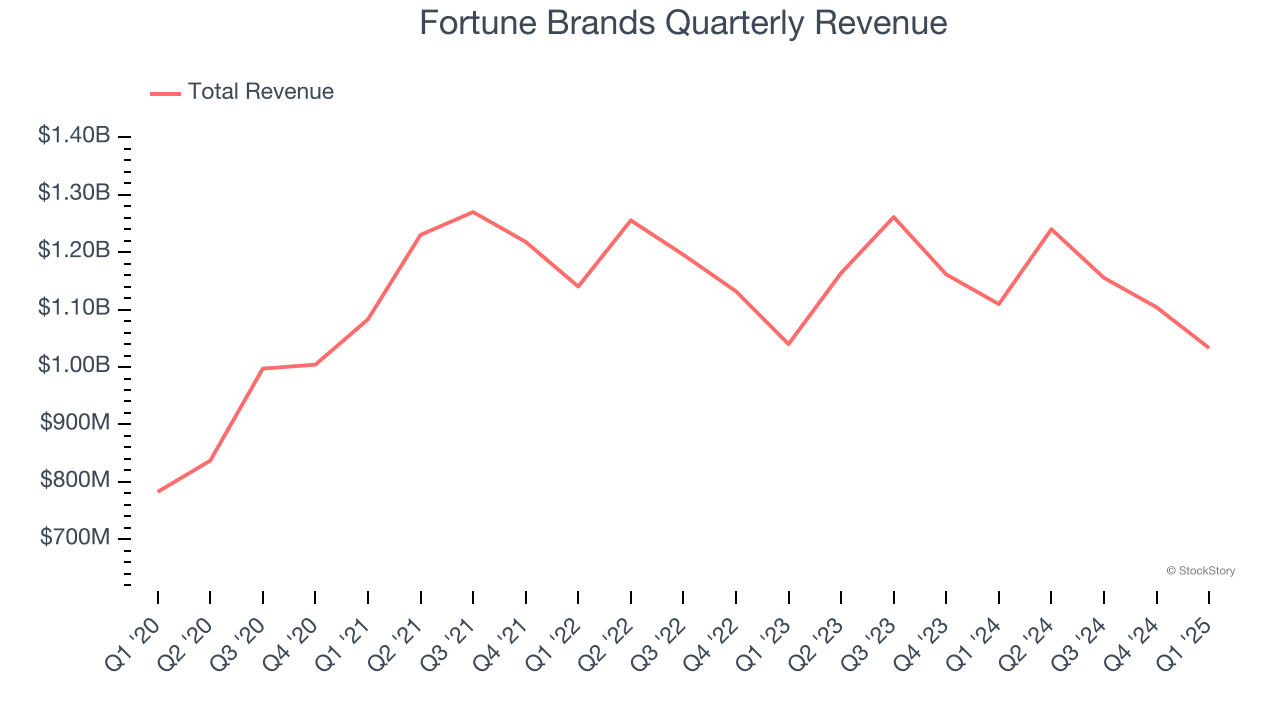
We at StockStory place the most emphasis on long-term growth, but within industrials, a half-decade historical view may miss cycles, industry trends, or a company capitalizing on catalysts such as a new contract win or a successful product line. Fortune Brands’s recent performance shows its demand has slowed as its revenue was flat over the last two years. 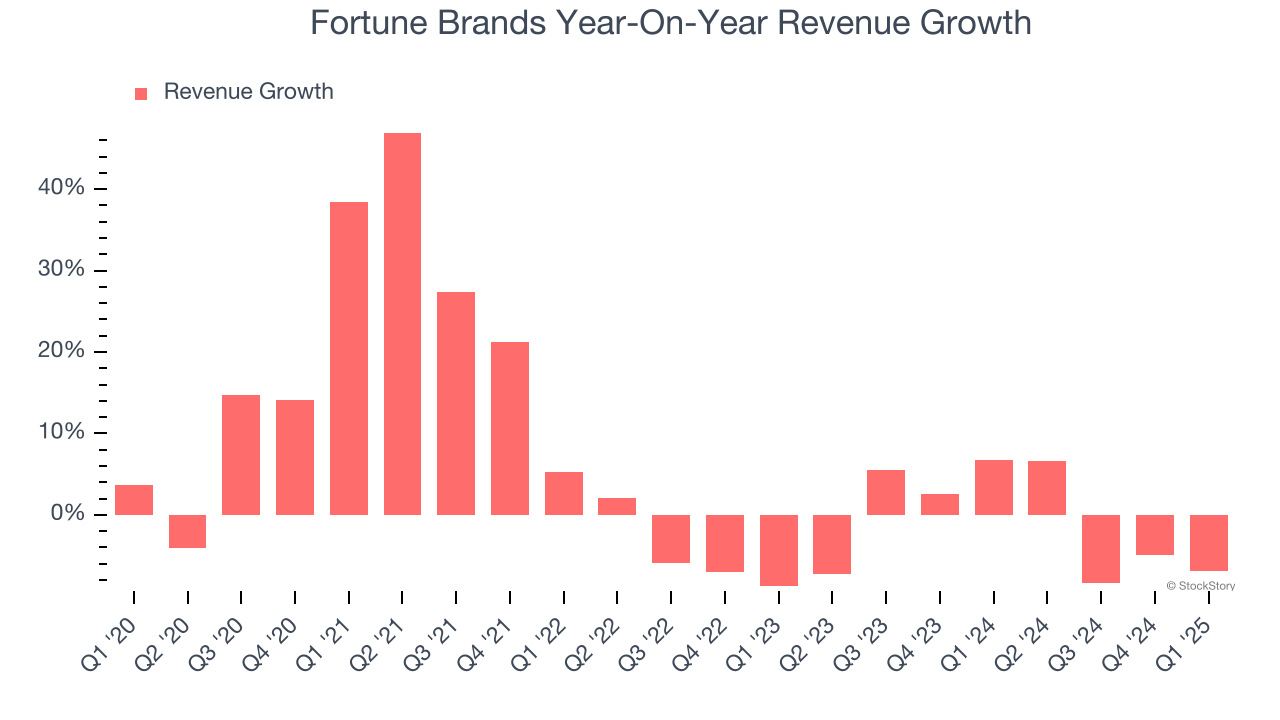
We can better understand the company’s sales dynamics by analyzing its organic revenue, which strips out one-time events like acquisitions and currency fluctuations that don’t accurately reflect its fundamentals. Over the last two years, Fortune Brands’s organic revenue averaged 2.7% year-on-year declines. Because this number is lower than its normal revenue growth, we can see that some mixture of acquisitions and foreign exchange rates boosted its headline results. 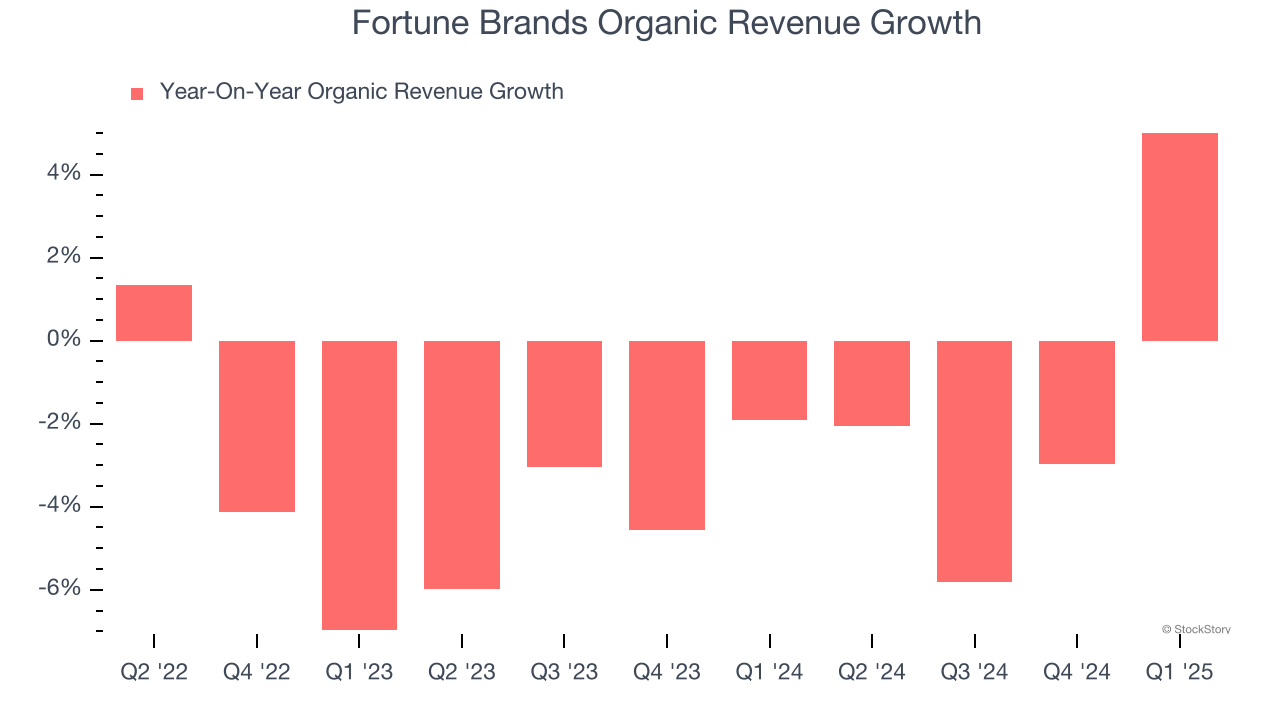
This quarter, Fortune Brands missed Wall Street’s estimates and reported a rather uninspiring 6.9% year-on-year revenue decline, generating $1.03 billion of revenue.
Looking ahead, sell-side analysts expect revenue to grow 3.1% over the next 12 months. Although this projection suggests its newer products and services will spur better top-line performance, it is still below the sector average.
Here at StockStory, we certainly understand the potential of thematic investing. Diverse winners from Microsoft (MSFT) to Alphabet (GOOG), Coca-Cola (KO) to Monster Beverage (MNST) could all have been identified as promising growth stories with a megatrend driving the growth. So, in that spirit, we’ve identified a relatively under-the-radar profitable growth stock benefiting from the rise of AI, available to you FREE via this link.
Operating Margin
Fortune Brands has been a well-oiled machine over the last five years. It demonstrated elite profitability for an industrials business, boasting an average operating margin of 17.2%. This result was particularly impressive because of its low gross margin, which is mostly a factor of what it sells and takes huge shifts to move meaningfully. Companies have more control over their operating margins, and it’s a show of well-managed operations if they’re high when gross margins are low.
Analyzing the trend in its profitability, Fortune Brands’s operating margin decreased by 7.8 percentage points over the last five years. This raises questions about the company’s expense base because its revenue growth should have given it leverage on its fixed costs, resulting in better economies of scale and profitability.
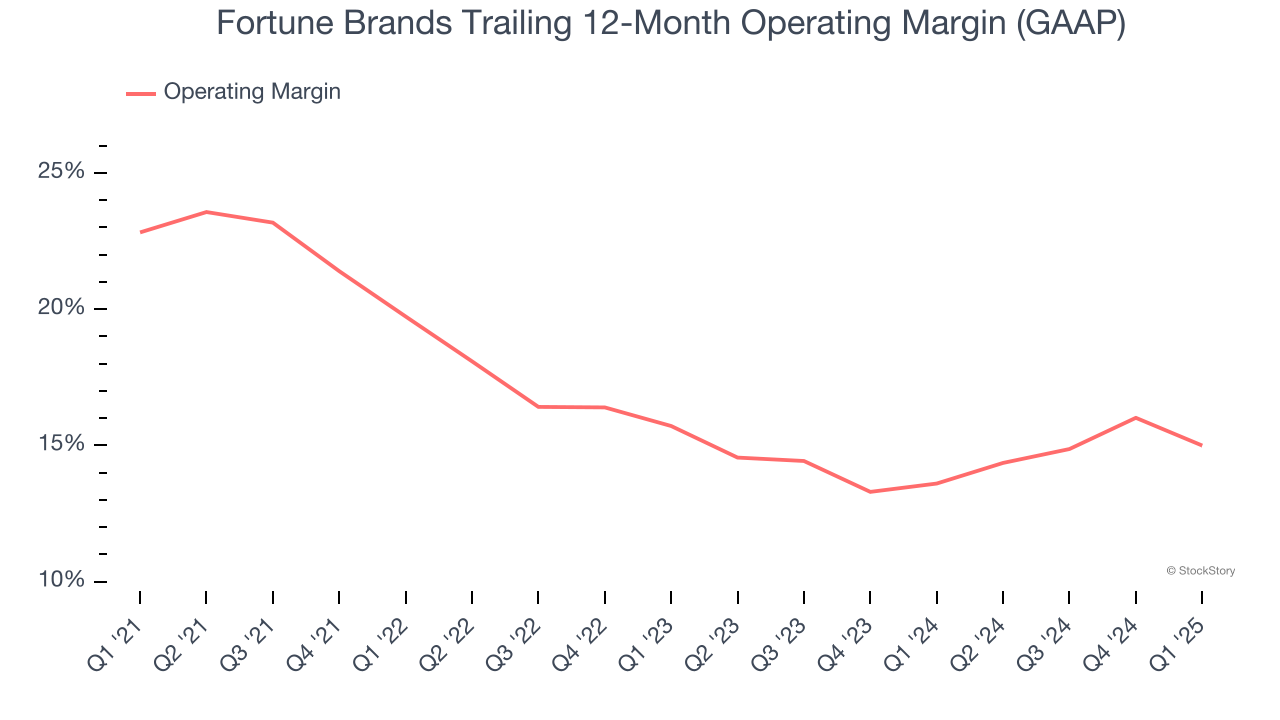
In Q1, Fortune Brands generated an operating profit margin of 9.4%, down 4.6 percentage points year on year. Since Fortune Brands’s operating margin decreased more than its gross margin, we can assume it was less efficient because expenses such as marketing, R&D, and administrative overhead increased.
Earnings Per Share
Revenue trends explain a company’s historical growth, but the long-term change in earnings per share (EPS) points to the profitability of that growth – for example, a company could inflate its sales through excessive spending on advertising and promotions.
Fortune Brands’s flat EPS over the last five years was below its 5.9% annualized revenue growth. This tells us the company became less profitable on a per-share basis as it expanded due to non-fundamental factors such as interest expenses and taxes.
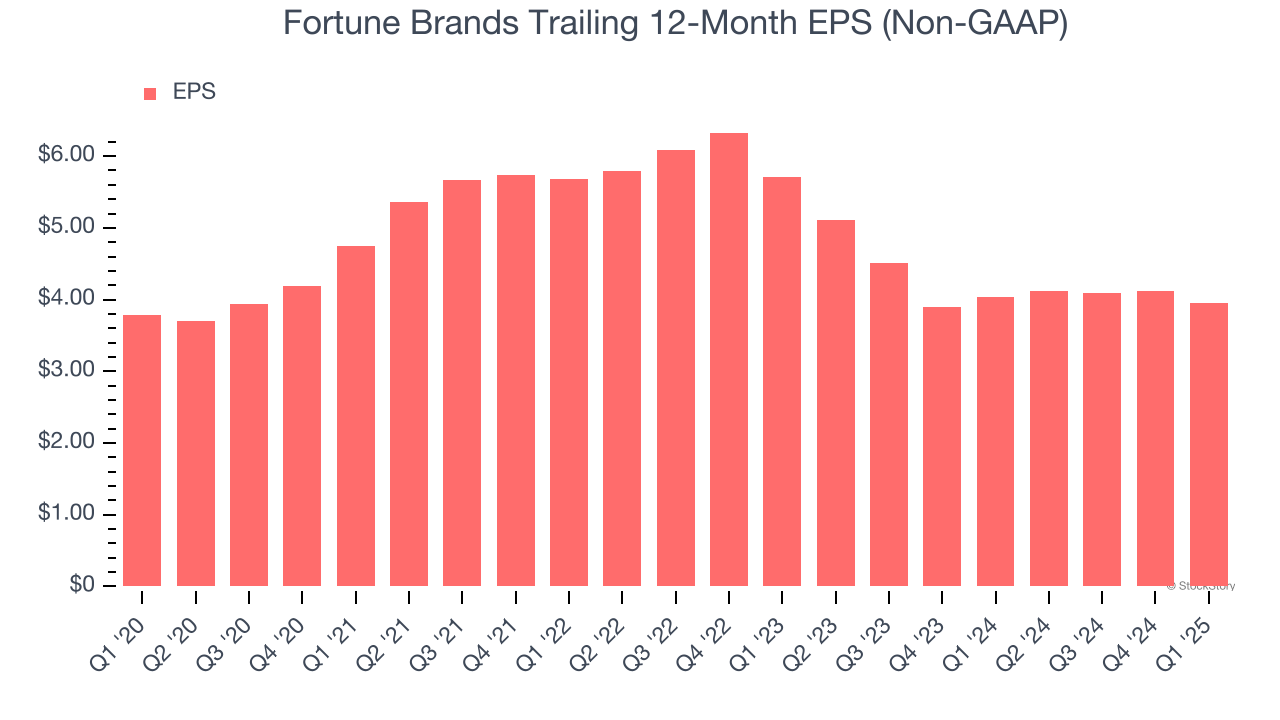
Diving into the nuances of Fortune Brands’s earnings can give us a better understanding of its performance. As we mentioned earlier, Fortune Brands’s operating margin declined by 7.8 percentage points over the last five years. This was the most relevant factor (aside from the revenue impact) behind its lower earnings; taxes and interest expenses can also affect EPS but don’t tell us as much about a company’s fundamentals.
Like with revenue, we analyze EPS over a more recent period because it can provide insight into an emerging theme or development for the business.
For Fortune Brands, its two-year annual EPS declines of 16.7% show its recent history was to blame for its underperformance over the last five years. These results were bad no matter how you slice the data.
In Q1, Fortune Brands reported EPS at $0.66, down from $0.83 in the same quarter last year. This print was close to analysts’ estimates. Over the next 12 months, Wall Street expects Fortune Brands’s full-year EPS of $3.95 to grow 8.5%.
Key Takeaways from Fortune Brands’s Q1 Results
We were impressed by how significantly Fortune Brands blew past analysts’ organic revenue expectations this quarter. On the other hand, its revenue missed significantly and its EBITDA fell slightly short of Wall Street’s estimates. Zooming out, we think this was a mixed quarter. The stock remained flat at $52.70 immediately following the results.
So do we think Fortune Brands is an attractive buy at the current price? We think that the latest quarter is only one piece of the longer-term business quality puzzle. Quality, when combined with valuation, can help determine if the stock is a buy. We cover that in our actionable full research report which you can read here, it’s free.
